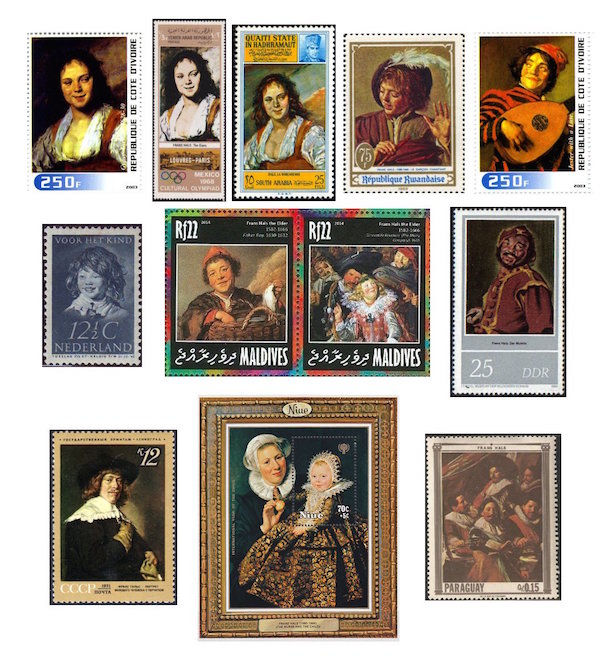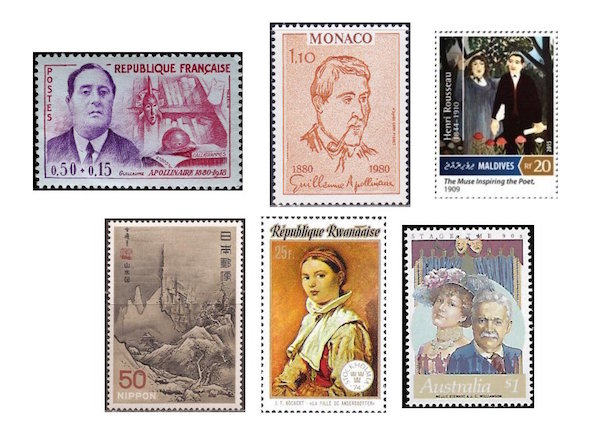The Arts on Stamps of the World — August 26
An Arts Fuse regular feature: the arts on stamps of the world.

By Doug Briscoe
Today’s headliners on Arts on Stamps of the World are Dutch painter Frans Hals the Elder, who died on this date in 1666, French poet Guillaume Apollinaire, American art collector Peggy Guggenheim, and American blues singer Jimmy Rushing. We’ll travel also to 15th-century Japan, 19th-century Sweden, as well as to Australia and Nicaragua today.
Frans Hals the Elder (c1582 – 26 August 1666) is one of those Old Masters whose work has been reproduced on a great many stamps from all over the world. One of the more famous pictures is Gypsy Girl (1628-30), which can be found on at least three different stamps. Two other familiar ones are of musicians: Singing Boy with Flute (c1623) and Jester with a Lute (1620-25). I was surprised I couldn’t locate a stamp showing perhaps the best known of all his works, The Laughing Cavalier (1624), but we do have one, in the second row, for a Laughing Boy (c1625). In fact, lots of Hals’s people are laughing or at least in excellent spirits. A joined pair from the Maldives shows Fisher Boy (1630-32) and Shrovetide Revellers (c1615), and one from the DDR offers The Mulatto (1627). At bottom center we have on a minisheet from Niue Catharina Hooft with her Nurse (c1619-20), and on either side of it we see Portrait of a Young Man on a Russian stamp and a detail from Banquet of the Officers of the St George Militia Company in 1627 on one of Paraguay.
Guillaume Apollinaire (26 August 1880 – 9 November 1918) was born Wilhelm Albert Włodzimierz Apolinary Kostrowicki in Rome. He grew up speaking Polish, Italian, and French. On relocating to Paris in his late teens adopted the French version of his name. He rubbed elbows with all the great names of that great milieu: Picasso, Gertrude Stein, Cocteau, Satie, Chagall, and many more. Apollinaire coined the terms “Orphism” and “Surreralism” in 1912 and 1917 respectively. (He had fought in World War I in 1916 and suffered a serious head wound from which he never fully recovered, but ultimately it was the Spanish flu that claimed his life at age 38). Best known as a poet, Apollinaire also wrote plays, short stories, and novels, including a couple of erotic ones. His poetical works were often set to music. He was a particular favorite of Poulenc, and his poetry was also set by at least three of the other members of Les Six: Honegger, Tailleferre, and Louis Durey. Other composers who were drawn to the imagery and language of Apollinaire include Shostakovich (in six of the eleven movements of his 14th Symphony), along with Bohuslav Martinů, Oliver Knussen, Barbara Kolb, and Kaija Saariaho. In addition to Apollinaire stamps from France (natch) and Monaco, we have the poet’s friend Henri Rousseau’s Muse Inspiring the Poet. Portrait of Apollinaire and Marie Laurencin of 1909 on a stamp from the Maldive Islands.

Perhaps the greatest Japanese master of ink and wash painting of his day, Sesshū Tōyō, born in 1420, died on this date in 1506. He was also known by the names Unkoku and Bikeisai. He was revered in both Japan and China, where he traveled in 1468-69. Few surviving works can definitely be attributed to him. One of them is Winter Landscape, dating from late in his life (c1470-90) and issued on a Japanese stamp in 1969.
For our next artist we move forward four hundred years. Swedish painter Johan Fredrik Höckert (26 August 1826 – 16 September 1866), not so well known in the U.S., is however one of Sweden’s favorite artistic sons. He went to Paris in 1851 and soon met with signal success there, returning to Sweden in 1857. There he painted Kerstin Andersdotter (1858), as seen on the stamp, and perhaps his most celebrated canvas, Fire in the Royal Palace, 7 May 1697.
The American actor and theater manager J(ames) C(assius) Williamson (August 26, 1845 – July 6, 1913) was born in Pennsylvania and was playing in amateur theatricals in Milwaukee from an early age. Then it was on to New York, San Francisco, and Australia, where he got the rights to put on Gilbert and Sullivan operettas. Over time, Williamson built up a veritable empire of theaters that grew to be the largest theatrical firm in the world. It was in Australia and New Zealand that Williamson left his deepest mark (it was he who brought Sarah Bernhardt Down Under), though he and his family put on shows throughout Europe and America. On one of a set of four Australian stamps of 1989, he is shown with actress Nellie Stewart, one of his protégées.

We remain in Australia for the painter Frances Vida Lahey (26 August 1882 – 29 August 1968), who came from Queensland. One of the first professional female artists in the country, Lahey had many exhibits of her work over a span of more that sixty years. She was also a teacher. Australia has twice issued stamps displaying her paintings: Fruit and Flowers (c1924) and Beach Umbrellas (1933). The painting that effectively launched her career, though, was Monday Morning (1912).
The magnum opus of French writer Jules Romains (26 August 1885 – 14 August 1972) is his 27-volume novel cycle Men of Goodwill (Les hommes de Bonne Volonté, 1932-1946). Frequently discussed as a Nobel Prize candidate, he also wrote poetry and at least one play. Romains, who was born Louis Henri Jean Farigoule in south-central France, devised the literary movement known as Unanimism (of which Men of Goodwill is an exemplar). He was a member of the Académie française from 1946.
I had never heard of Luis Abraham Delgadillo until I got one of his two stamps, but he was an interesting figure. Online sources differ as to his birthday, with Grove Online and La web de las biografías giving August 25th; Spanish, Catalan, and French Wikipedia citing the 26th; and German Wiki August 29th. I arbitrarily chose the date in the middle. Gracias Luis Abraham Delgadillo Rivas was born in Managua in 1887. Through the good offices of Nicaraguan president José Santos Zelaya (a great progressive statesman), Delgadillo was able to attend the Milan Conservatory, from which he was graduated with honors. In 1918 he wrote what twenty years later became the Nicaraguan national anthem (set to new words and mandated by the not so progressive Anastasio Somoza). Delgadillo taught at the Mexico Conservatory from 1921 to 1925 and the Panama National School of Music from 1943 to 1945, besides being director, with absences, of the first National School of Music in Managua from 1937. Grove Music Online cites him as being “the first Nicaraguan to write large orchestral works.” Some of these, such as his Sinfonía Incaica and Suite “Teotihuacán” reflect the aboriginal culture of the New World. He died on December 20, 1961. Besides the stamp from his native country he is honored on a Cuban stamp, part of a large set commemorating various Latin American composers and musicians. (Each composer is shown with a musical instrument, not always an entirely appropriate one. Another stamp from the same set is up tomorrow.)

Peggy Guggenheim (August 26, 1898 – December 23, 1979) was born to a very wealthy New York family of Jewish Ashkenasi descent. She fell in love with the arts, worked in an avant-garde bookstore, inherited millions on the death of her father (who went down with the Titanic when she was 19), and moved to Paris to hob nobs with the crème de la crème of the bohemian art scene. Man Ray, whose birthday is tomorrow, photographed her. In 1938 she opened her first gallery in London and was well on her way to building her magnificent art collection. It was in the following year that the Museum of Non-Objective Painting was established. This would be renamed the Guggenheim Museum in 1952. I confess that for many years I assumed the museum was named for Peggy, but it fact its name derives from her uncle Solomon R. Guggenheim. The world-famous building that houses the collection, built in 1959, can be seen on a couple of stamps, but we’ve already seen those in connection with our piece on Frank Lloyd Wright. Peggy went on to found another art museum, though, now called the Peggy Guggenheim Collection, in her home, the Palazzo Venier dei Leoni, in Venice, and that’s why today’s Guggenheim stamp is an Italian one.
James Andrew “Jimmy” Rushing (August 26, 1901 – June 8, 1972) was born in Oklahoma City to a musical family and toured the region and points west until arriving at Los Angeles, where he met up with Jelly Roll Morton. He sang with the Bennie Moten band and stayed with it as it morphed into the Count Basie Orchestra. A gentleman of some girth, he came to be known as “Mr. Five by Five”, based on a 1942 song of that name about a man who was “five feet tall and five feet wide”. The same might be said of Rushing’s powerful voice. In later years Rushing would work with Duke Ellington and Dave Brubeck, among many others.
There’s no stamp for Christopher Isherwood (26 August 1904 – 4 January 1986).
A graduate of the University of Massachusetts with a B.A. in English, Doug Briscoe worked in Boston classical music radio, at WCRB, WGBH, and WBUR, for about 25 years, beginning in 1977. He has the curious distinction of having succeeded Robert J. Lurtsema twice, first as host of WGBH’s weekday morning classical music program in 1993, then as host of the weekend program when Robert J.’s health failed in 2000. Doug also wrote liner notes for several of the late Gunther Schuller’s GM Recordings releases as well as program notes for the Boston Classical Orchestra. For the past few years he’s been posting a Facebook “blog” of classical music on stamps of the world, which has now been expanded to encompass all the arts for The Arts Fuse.
